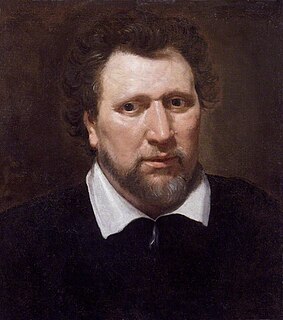Related Research Articles

Benjamin Jonson was an English playwright and poet. Jonson's artistry exerted a lasting influence upon English poetry and stage comedy. He popularised the comedy of humours; he is best known for the satirical plays Every Man in His Humour (1598), Volpone, or The Fox, The Alchemist (1610) and Bartholomew Fair (1614) and for his lyric and epigrammatic poetry. "He is generally regarded as the second most important English dramatist, after William Shakespeare, during the reign of James I."

Thomas Middleton was an English Jacobean playwright and poet. He, along with John Fletcher and Ben Jonson, was among the most successful and prolific of the playwrights at work in the Jacobean period. Middleton was among the few to achieve equal success in comedy and tragedy. He was also a prolific writer of masques and pageants.

Sir William Davenant, also spelled D'Avenant, was an English poet and playwright. Along with Thomas Killigrew, Davenant was one of the rare figures in English Renaissance theatre whose career spanned both the Caroline and Restoration eras and who was active both before and after the English Civil War and during the Interregnum.
This article contains information about the literary events and publications of 1618.

George Chapman was an English dramatist, translator and poet. He was a classical scholar whose work shows the influence of Stoicism. Chapman has been speculated to be the Rival Poet of Shakespeare's sonnets by William Minto, and as an anticipator of the metaphysical poets of the 17th century. Chapman is best remembered for his translations of Homer's Iliad and Odyssey, and the Homeric Batrachomyomachia.

Ben Jonson collected his plays and other writings into a book he titled The Workes of Benjamin Jonson. In 1616 it was printed in London in the form of a folio. Second and third editions of his works were published posthumously in 1640 and 1692.
Oberon, the Faery Prince was a masque written by Ben Jonson, with costumes, sets and stage effects designed by Inigo Jones, and music by Alfonso Ferrabosco and Robert Johnson. Oberon saw the introduction to English Renaissance theatre of scenic techniques that became standard for dramatic productions through the coming centuries.
The Golden Age Restored was a Jacobean era masque, written by Ben Jonson and designed by Inigo Jones; it was performed on 1 January and 6 January 1616, almost certainly at Whitehall Palace.
Mercury Vindicated from the Alchemists at Court is a Jacobean-era masque, written by Ben Jonson and designed by Inigo Jones. It was performed at Whitehall Palace on Twelfth Night, 6 January 1615. King James I liked it so much that he ordered a repeat performance the following Sunday, 8 January.
The Entertainment at Althorp, or The Althorp Entertainment, is an early Jacobean era literary work, written by Ben Jonson. It is also known by the alternative title The Satyr. The work marked a major development in Jonson's career, as the first of many entertainments and masques that he would write for the Stuart Court.
The Speeches at Prince Henry's Barriers, sometimes called The Lady of the Lake, is a masque or entertainment written by Ben Jonson in honour of Henry Frederick, Prince of Wales, the son and heir of King James I of England. The speeches were performed on 6 January 1610 in conjunction with the ceremony known as Prince Henry's Barriers.
Pleasure Reconciled to Virtue is a Jacobean era masque, written by Ben Jonson and designed by Inigo Jones. It was first performed on Twelfth Night, 6 January 1618, in the Banqueting House at Whitehall Palace. The work's failure on its initial performance, and its subsequent revision, marked a significant development in Jonson's evolving masque technique.
The Masque of Augurs was a Jacobean era masque, written by Ben Jonson and designed by Inigo Jones. It was performed, most likely, on Twelfth Night, 6 January 1622.
The King's Entertainment at Welbeck in Nottinghamshire, alternatively titled Love's Welcome at Welbeck, was a masque or entertainment written by Ben Jonson, and performed on 21 May 1633 at the Welbeck estate of William Cavendish, 1st Duke of Newcastle. It has been argued that the philosopher Thomas Hobbes may have participated in the entertainment as a performer.
Time Vindicated to Himself and to his Honours was a late Jacobean era masque, written by Ben Jonson and with costumes, sets, and stage effects designed by Inigo Jones. James's son and heir Prince Charles led the dances of the principal masquers, as he had in several previous masques at the Stuart Court.
The Vision of Delight was a Jacobean era masque written by Ben Jonson. It was most likely performed on Twelfth Night, 6 January 1617 in the Banqueting House at Whitehall Palace, and repeated on 19 January that year.
Lovers Made Men, alternatively titled The Masque of Lethe or The Masque at Lord Hay's, was a Jacobean era masque, written by Ben Jonson, designed by Inigo Jones, and with music composed by Nicholas Lanier. It was performed on Saturday 22 February 1617, and was significant in the development and acceptance of opera in seventeenth-century England.
News from the New World Discovered in the Moon was a Jacobean era masque, written by Ben Jonson; it was first performed before King James I on 7 January 1620, with a second performance on 29 February the same year. Jonson's text comments on significant recent developments in astronomy and journalism. The text of the masque was first published in the second folio collection of Jonson's works in 1641.
John Auchmoutie of Scoughall was a Scottish courtier.
Robert Abercromby was a Scottish leatherworker serving the Scottish monarchy in the 16th century.